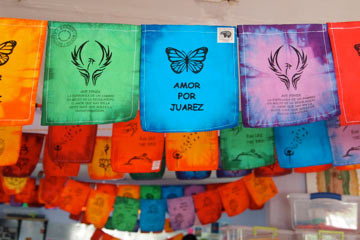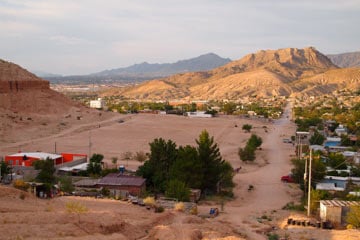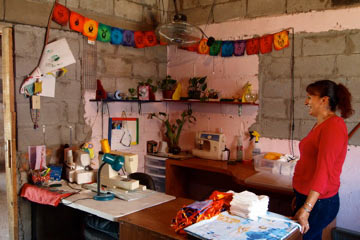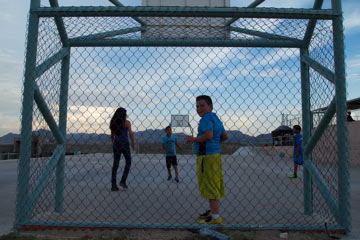
A group of five women, along with one American aid worker, have carved out a place of peace in the troubled and often violence-wracked neighborhood of Rancho Anapra in Juarez, Mexico. After scraping by for years – all of the women at some point toiling away in maquiladoras (factories) – they now produce what one of the women, Siba Escobedo, proudly claims are the “most well-made prayer flags in the world.” In a moment of increased union organizing across the city, this guerrilla collective has banded together to create an alternative to the booming maquila-capitalism in Juarez. They create the prayer flags – colorful strings of fabric squares, inspired by the Buddhist prayer flags often used in Nepal and Tibet, often hung above doorways and bearing messages such as “Amor por Juarez” (Love for Juarez) – out of two small makeshift workshops.
Many evenings Sofia Aleman, a founding member of the guerrilla collective, massages Montserrat, a cheerful ten-year-old girl who suffered infant paralysis and has limited control of her muscles. During the day Aleman makes prayer flags, even as she cooks for twenty people, cleans, drives a bus and volunteers her time for the Proyecto Santo Niño community center, which offers services for special needs children of Juarez. Aleman has lived in the impoverished Juarez suburb of Rancho Anapra since before the city ran plumbing that way. “Drug war” violence in the area sparked in the early 2000s, as competing cartels vied for the territory and the state responded by sending in an army accused of widespread abuse, but since then it has abated somewhat.
This tightly packed barrio has a rapidly expanding maquila industry, but it is also home to Escobedo and Aleman’s underground collective: five women and a coterie of their children (fourteen when they are at full capacity) who support themselves making and selling their “Guerilla Prayer Flags.”
The members of the collective, like many women in Rancho Anapra, struggled to survive through the fear and loneliness that gripped the city for years. (The murder rate reached as high as almost 10 murders a day in 2010.) And even before the long season of murders and femicides, which lasted from the mid-2000s to around 2013, according to their own estimates, poverty and hard times at the maquilas dominated their lives.
 View of Anapra’s sand soccer field. (Photo: John Washington)The first houses in Rancho Anapra, Aleman explained to me, were clapboard shanties built straight on top of the sand. The first inhabitants – Aleman and her family among them – came about 30 years ago. Despite a recent uptick in building projects, the sand still seems to dominate, pouring over the streets, dumping its thick damper on much of the barrio. With its proximity to industrial boomtown Ciudad Juarez, as well as the international border, geographic and economic growth seemed inevitable. But for years the violence cut deeply at all aspects of life and still thwarts personal economic growth for most Anapra inhabitants.
View of Anapra’s sand soccer field. (Photo: John Washington)The first houses in Rancho Anapra, Aleman explained to me, were clapboard shanties built straight on top of the sand. The first inhabitants – Aleman and her family among them – came about 30 years ago. Despite a recent uptick in building projects, the sand still seems to dominate, pouring over the streets, dumping its thick damper on much of the barrio. With its proximity to industrial boomtown Ciudad Juarez, as well as the international border, geographic and economic growth seemed inevitable. But for years the violence cut deeply at all aspects of life and still thwarts personal economic growth for most Anapra inhabitants.
Sofia Loren, Aleman’s daughter, a wide-eyed, whip-smart, loud-laughing seventeen-year-old, described to me the violence she’s suffered, most of it perpetrated by the police. She’s been harassed, threatened, and physically abused by police officers “at least ten times,” she said.
In one incident in 2013, when she was 15, she was walking down the street with her boyfriend when a police truck stopped them. Four male officers and two female officers were inside. She said she was a little drunk but was not doing anything to warrant a police stop. When one of the officers was patting her down for a search, she said he lifted up her shirt and exposed her breasts. She pulled her shirt down and the cop accused her of resisting him. Officers twisted her arms behind her back and threw her in the truck. Eventually, after her mother paid $100, they released her in another part of the city. They also stole her cell phone. She told me that she didn’t know where they were taking her, but they hadn’t taken her to a police station and she wasn’t sure that’s where they were headed.
I asked Sofia Loren what she felt when she saw a police officer.
“Coraje,” she answered. “Rage.”
“Not fear?” I asked.
“No,” she told me, “just coraje.”
Her goal is to be a criminologist. “They humiliate us,” she said, referring to the police treatment of the poor. “But if I can become a boss, I can change things.” Even the news disparages Anapra, Sofia Loren explained, adding, “They think we don’t have water here.” Ten years ago Anapra had no running water.
“They think we live in the desert,” she said. “They think we live with cows. But I have a better house than them. It’s small, and humble, but it’s clean.”
The women in the Guerilla Prayer Flags collective founded the project in part to nurture this sort of self-respect in their children. Speaking of how they hope to give their children a brighter future, tears hung in their eyes. Aleman said that her own ultimate goal is to help each of her five children, as well as the other children she cares for, to live in their own homes. Though the flag business is growing rapidly, this goal may be still far off.
The initial idea wasn’t to create prayer flags. Aleman was looking for any way to put food on the table: She tried working in the maquilas, then running a hamburger stand out of her house, then both at the same time, but still the money wasn’t enough. She then started redesigning used clothing to sell and thought of running a restaurant out of her home. I ate her eye-wateringly spicy cream of jalapeño soup, as well as her bright red menudo and can attest that she has the kitchen skills and the sazón for the business. Seeing her neighbors being extorted and even killed, however, convinced her that it wasn’t worth trying to open a restaurant.
“The hoodlums,” Escobeda explained to me, see prayer flags and simply “don’t get it.” They don’t see it as a business worth extorting; thus, it’s safer than a restaurant – the running of which would inevitably entail paying high “protection fees” to the gangs. Aleman explained that anybody in town who is making money and who has found some semblance of success is targeted as prey by the extortionists. She herself was threatened to be killed when driving the bus for the Proyecto Santo Niño. Other bus drivers thought she was encroaching on their territory without paying the quota to the mafia.
 Perla Lopez giving a tour of her workshop space, which she’s set up in the corner of her two-room home. A fan hangs from the ceiling to keep her cool. (Photo: John Washington)Perla Lopez, Aleman’s youngest sister, moved to Rancho Anapra from a different part of Juarez at 14 years old. “There was nothing here,” she said, “not even dirt. Just sand.” After arriving, she stopped going to school and started working at a maquila, where she made wire harnesses for cars. She worked sometimes until midnight, but was increasingly terrified for her own safety, especially when, in the ’90s, news of femicides started spreading throughout Juarez. Aleman told me that when parents are forced to work in the maquilas “The children’s spirits aren’t taken care of,” that they are essentially raising themselves because of the long hours the parents are forced to work. It’s impossible, Aleman described, “to break the chain of work-run-run, working all the time.” Both she and Lopez see the prayer flags as a way to step out of the vortex of violence and poverty. They “just want to be respected as human beings,” Aleman told me. Though “we’re in the eye of the hurricane” of violence, as Lopez put it, “we find peace here.”
Perla Lopez giving a tour of her workshop space, which she’s set up in the corner of her two-room home. A fan hangs from the ceiling to keep her cool. (Photo: John Washington)Perla Lopez, Aleman’s youngest sister, moved to Rancho Anapra from a different part of Juarez at 14 years old. “There was nothing here,” she said, “not even dirt. Just sand.” After arriving, she stopped going to school and started working at a maquila, where she made wire harnesses for cars. She worked sometimes until midnight, but was increasingly terrified for her own safety, especially when, in the ’90s, news of femicides started spreading throughout Juarez. Aleman told me that when parents are forced to work in the maquilas “The children’s spirits aren’t taken care of,” that they are essentially raising themselves because of the long hours the parents are forced to work. It’s impossible, Aleman described, “to break the chain of work-run-run, working all the time.” Both she and Lopez see the prayer flags as a way to step out of the vortex of violence and poverty. They “just want to be respected as human beings,” Aleman told me. Though “we’re in the eye of the hurricane” of violence, as Lopez put it, “we find peace here.”
International business imperatives have become part of the storm that is buffeting the residents of Juarez. In 2008, just a few miles from Rancho Anapra, in the sand-blowing desert, US and Mexican officials established a free-trade zone. Within 9 weeks Taiwanese electronics giant Foxconn bought land for a new 1.3 million square foot facility. Known in the US for the spate of worker suicides in its mega-campuses in China between 2010 and 2013, Foxconn broke ground outside of Anapra as the violence was rising to levels never before seen in the city (almost ten murders a day in 2010). And yet Foxconn was part of a “master-planned border community,” producing as many as 55,000 computers a day, or a million a month, insulating itself – if not its workers – from the wave of murders and kidnappings. The typical weekly wage working at a maquila, according to many Juarenses I spoke with, is a mere $50 a week, and work conditions remain dismal. This past August 12, around 200 Foxconn employees participated in a one-day strike, protesting low wages, unjustified firings, and sexual harassment committed by supervisors.
There is a new Tech University in Anapra, the Universidad Tecnológica Paso del Norte, which first opened in 2014, with currently about 1,200 students. At first it seemed to herald a better future, but the career tracks are all geared towards industrial and service jobs, funneling the youth into the maquilas. The high schools in Anapra are similarly maquila-focused. “They don’t even teach the humanities” in any of the Anapra high schools, Aleman told me. Many local youth, however, don’t even try for high school, instead entering directly into the labor force after secundaria, which corresponds to US grades 7-9. The economy of Anapra may be rising up from out of the underground market, but it seems to be rising so quickly into the ether of free trade economics that though the dollars are flowing, they are flowing above the heads – and out of reach – of the workers.
This is why the Guerilla Prayer Flags project seems to shine so brightly for these women. Another of the core members of the collective, Guadalupe Rodriguez, after struggling for years in an abusive relationship, and then trying to raise three daughters (including Montserrat, the 10-year-old who suffered infant paralysis), started coming to Santo Niño, a community center in Anapra that focuses on helping families with special needs children, in 2011. When she started working with the Guerilla Prayer Flags, she finally found a way to make a decent living and raise her daughters in peace.
 Children of Sofia Aleman and Guadalupe Rodriguez play soccer on a court close to the Universidad Tecnológica Paso del Norte, which is seen as a funnel for Anapra youth to enter the maquilas. (Photo: John Washington)Each of the women now makes about $120 a week, more than twice the typical maquila wage. But the project is not just about money. It’s also about dignity. As described in a Santo Niño newsletter, some of these women see themselves as “slave[s] or even property” of their husbands. Working for themselves has, according to Rodriguez, “helped us grow as a family. Helped us build solidarity … helped us find security.” Without the prayer flags, and the community she has found in producing them, Rodriguez doesn’t think her special needs daughter would have received the support that has led to her recent progress. Before 2011, Montserrat couldn’t sleep unless she was being hugged by her mother. She couldn’t grasp objects or try to walk. Now she can partially feed herself and will sleep alone. She is frequently massaged by Aleman, and Rodriguez hopes that she will be able to take her first steps within a year.
Children of Sofia Aleman and Guadalupe Rodriguez play soccer on a court close to the Universidad Tecnológica Paso del Norte, which is seen as a funnel for Anapra youth to enter the maquilas. (Photo: John Washington)Each of the women now makes about $120 a week, more than twice the typical maquila wage. But the project is not just about money. It’s also about dignity. As described in a Santo Niño newsletter, some of these women see themselves as “slave[s] or even property” of their husbands. Working for themselves has, according to Rodriguez, “helped us grow as a family. Helped us build solidarity … helped us find security.” Without the prayer flags, and the community she has found in producing them, Rodriguez doesn’t think her special needs daughter would have received the support that has led to her recent progress. Before 2011, Montserrat couldn’t sleep unless she was being hugged by her mother. She couldn’t grasp objects or try to walk. Now she can partially feed herself and will sleep alone. She is frequently massaged by Aleman, and Rodriguez hopes that she will be able to take her first steps within a year.
I asked Aleman if she saw her work with the prayer flags as an act of resistance, which was how Escobeda described it to me. She said: “We don’t have guns, but this [creating the flags] is my weapon. This is defending my land, demanding respect … We’re not waging war; we’re waging peace.”
“If you’re not in harmony with the colors” as you’re dyeing them, Lopez put it, “they don’t come out.” Our children “find peace here,” she said. “We are expressing ourselves.”
Our most important fundraising appeal of the year
December is the most critical time of year for Truthout, because our nonprofit news is funded almost entirely by individual donations from readers like you. So before you navigate away, we ask that you take just a second to support Truthout with a tax-deductible donation.
This year is a little different. We are up against a far-reaching, wide-scale attack on press freedom coming from the Trump administration. 2025 was a year of frightening censorship, news industry corporate consolidation, and worsening financial conditions for progressive nonprofits across the board.
We can only resist Trump’s agenda by cultivating a strong base of support. The right-wing mediasphere is funded comfortably by billionaire owners and venture capitalist philanthropists. At Truthout, we have you.
We’ve set an ambitious target for our year-end campaign — a goal of $250,000 to keep up our fight against authoritarianism in 2026. Please take a meaningful action in this fight: make a one-time or monthly donation to Truthout before December 31. If you have the means, please dig deep.